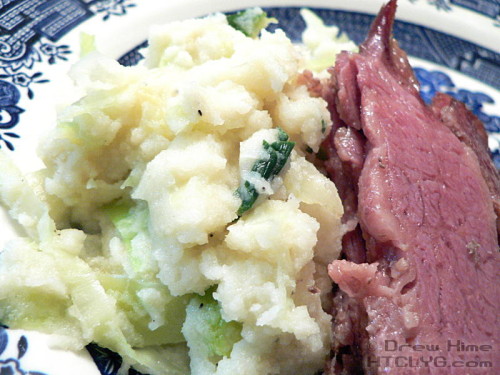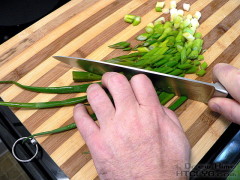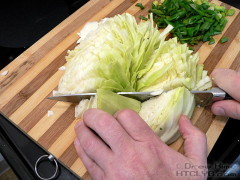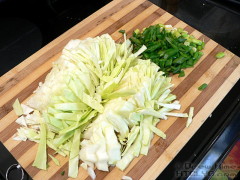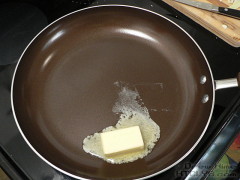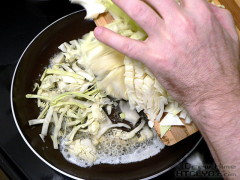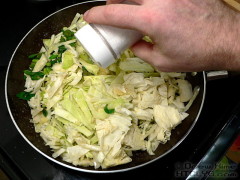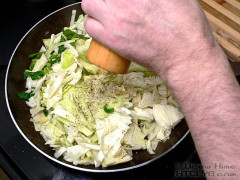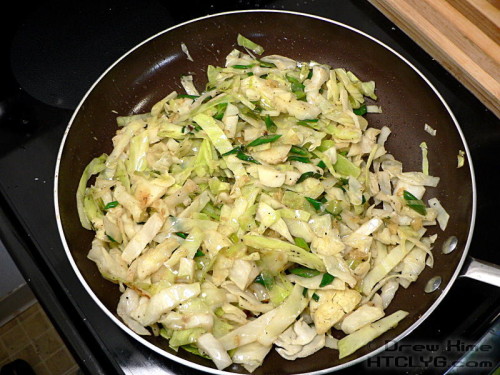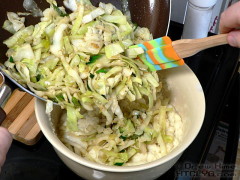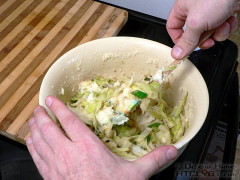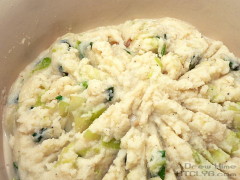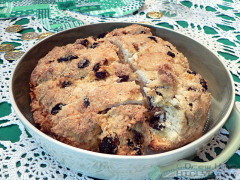If you’re looking for authentic Irish food for St. Patrick’s Day, don’t go with corned beef and cabbage. That’s the American version of Irish food. A bit more authentic is colcannon, which is really more of an idea than a strict recipe.
Short version: Cook and mash some root vegetables, sauté some cruciform vegetable (cabbage, leek, broccoli, cauliflower) and mix it all together.
Long version …
Ingredients
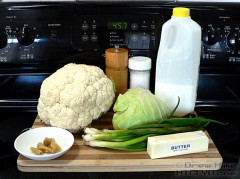 3 lbs. potatoes (see below)
3 lbs. potatoes (see below)
3 cloves fresh garlic (see below)
4 T Irish Butter
4 cups Kale or green Cabbage, shredded
4 scallions, diced fine with green tops
¼ – ½ cup warm Milk, Cream or Half & Half (see below … again)
Salt & Pepper to taste
Directions
I have to start off by saying I got this recipe from Jan, and that I didn’t do it exactly according to the recipe. The biggest change was that instead of potatoes I used mashed cauliflower. I eat low-carb during the week, and I wanted to see if I could come up with a new side dish without carbs. Here’s a quick lesson on how to use roasted cauliflower as a low-carb alternative to mashed potatoes.
Otherwise, peel and dice the potatoes, boil until fork tender, then drain and mash them with some cream, milk or butter. We had about a gallon of buttermilk left after making the soda bread, so we used that.
Before anyone gets all, “That’s not how my grandmother made it,” historically this is totally within the spirit of how to make colcannon.1 Uh huh… Yes it is… Is so… Is so… (But of course feel free to make it with potatoes.)
Dice your greens, which this time was scallions (green onions) with the green part, and a quarter-head of white cabbage.
Melt the butter in a large skillet and add the greens.
Season with salt, pepper, and the garlic, minced.
I didn’t have any fresh garlic, so I was about to use some garlic powder. Then, when I was getting the butter out of the fridge, I found the jar of roasted garlic my father-in-law gave me a while back. Well hey, let’s use that!
Toss the greens over high heat until wilted but not browned.
You could actually stop right here and serve it like this.
In fact, I’ve got another cabbage in the fridge that I’ll be doing this way later this week.
But for the colcannon, add the sautéed greens to the mashed potatoes (or cauliflower).
If you want it to look nice when you serve it, transfer to another bowl or just scrape down the sides.
Slice the soda bread and place in a nice dish.
Wait … soda bread? Well, yeah. You’re making this for St. Patrick’s Day, aren’t you? Of course you’ve got soda bread.
And you’ve also got corned beef, which goes just great with this.
And that’s it.
1) I was asked a few times when I said I was making it what “Colcannon” means. I didn’t know, so I looked it up. Here’s what I found:
Irish Gaelic cál reflects an ancient Indo-European word for cabbage, literally vegetable on a stalk (IE kaul ‘stalk’). Related forms are: Old English cal (giving colewort “cabbage plant,” an older name for one loose-leaved variety), Old Scandinavian kal (giving English kale and modern Norwegian kaal), German Kohl (giving Kohlrabi), Latin caulis (think of cauliflower, a plant in the same botanical family as cabbage; think too of various words for cabbage, derivatives of caulis in the Romance languages, for example Spanish col and French chou), Greek kaulos, Medieval Dutch kool (in MD cabbage salad was kool sla, giving modern English coleslaw). Finally, showing the true spread of this cabbage word, a cognate appears in ancient Persian as kelum.
So cole slaw, cauliflower, kohlrabi, colcannon, and kale all come from the same root word, and are all in the same family. Cool. Or is that caul?
Either way, what that means is “colcannon” is mashed root vegetables with sautéed cruciform greens. So I just mashed one cruciform green and mixed in a sautéed different cruciform green.
